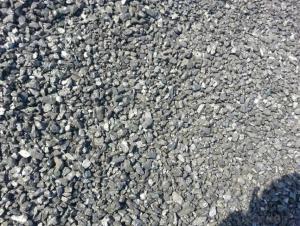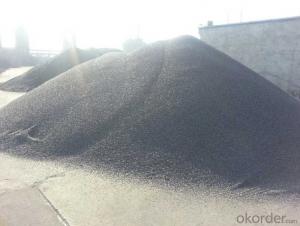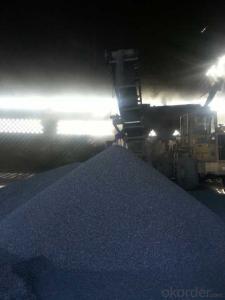Recarburizer FC80-90 with stable quality
- Loading Port:
- Tianjin
- Payment Terms:
- TT OR LC
- Min Order Qty:
- 20 m.t.
- Supply Capability:
- 3000 m.t./month
OKorder Service Pledge
OKorder Financial Service
You Might Also Like
Packaging & Delivery
25kgs/50kgs/1ton per bag or as buyer's request
Specifications
Calcined Anthracite
Fixed carbon: 90%-95%
S: 0.5% max
Size: 0-3. 3-5.3-15 or as request
It used the high quality anthracite as raw materials through high temperature calcined at over 2000 by the DC electric calciner with results in eliminating the moisture and volatile matter from anthracite efficiently, improving the density and the electric conductivity and strengthening the mechanical strength and anti-oxidation. It has good characteristics with low ash, low resistvity, low sulphur, high carbon and high density. It is the best material for high quality carbon products.
Advantage and competitive of caclined anthracite:
1. strong supply capability
2. fast transportation
3. lower and reasonable price for your reference
4.low sulphur, low ash
5.fixed carbon:95% -90%
6..sulphur:lower than 0.3%
General Specification of Calcined Anthracite:
| FC | 80 | 83 | 85 | 88 | 90 |
| ASH | 16 | 14 | 13 | 10 | 8.5 |
| V.M. | 3 | 3 | 2 | 2 | 1.5 |
| S | 0.5 | 0.5 | 0.5 | 0.5 | 0.35 |
| MOISTURE | 2 | 2 | 1 | 1 | 0.5 |
Pictures
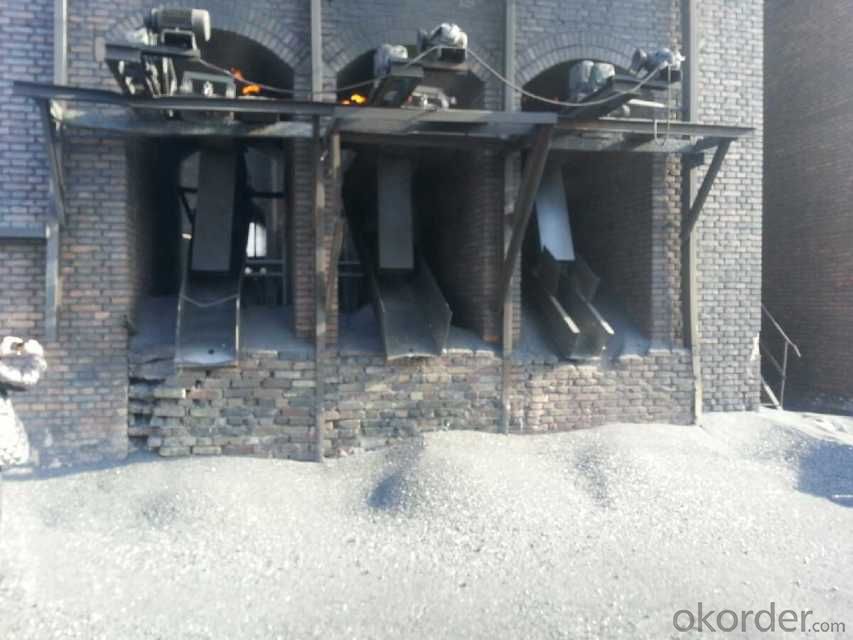
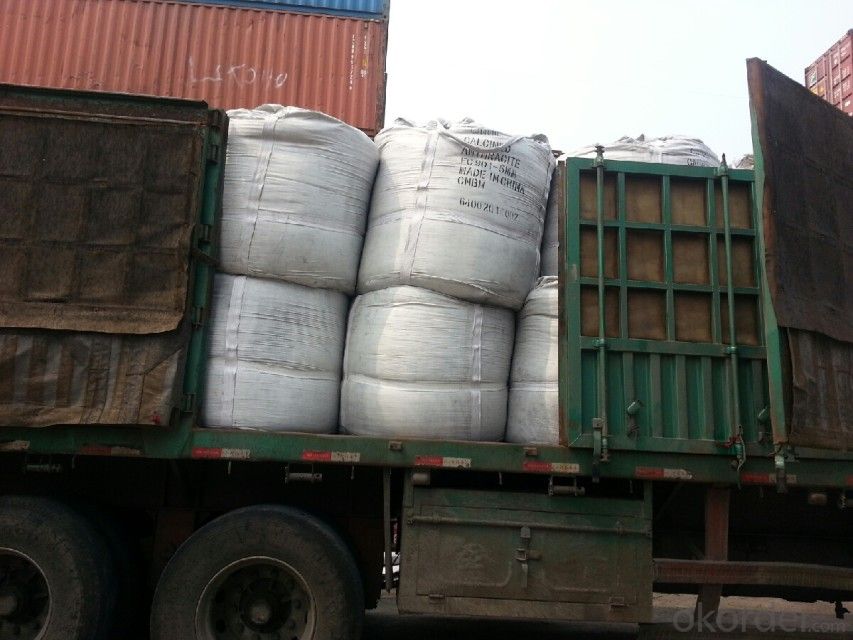
We are also strong at below materials, please contact us if you are interested in any of them:
Calcined Petroleum Coke
Carbon Electrode Paste
Carbon Electrode
- Q:How does carbon impact the structure and function of ecosystems?
- Carbon plays a crucial role in shaping the structure and function of ecosystems. It is a fundamental building block of life and is involved in various biological processes. Carbon is the primary component of organic matter, such as plants, animals, and microorganisms, which form the basis of food webs and provide energy to other organisms. Carbon dioxide (CO2) is also an essential greenhouse gas that regulates the Earth's temperature. Through photosynthesis, plants absorb CO2 from the atmosphere and convert it into organic carbon compounds, releasing oxygen as a byproduct. This process not only fuels the growth of plants but also maintains the balance of atmospheric gases, supporting life on Earth. Additionally, carbon influences the cycling of nutrients within ecosystems. Decomposition of organic matter by decomposers releases carbon back into the environment, enabling its reuse by other organisms. This carbon cycling is vital for nutrient availability and contributes to the overall productivity of ecosystems. However, human activities, such as burning fossil fuels and deforestation, have significantly increased carbon dioxide levels in the atmosphere. This excess carbon disrupts the natural balance, leading to climate change and its associated impacts on ecosystems. Rising temperatures, altered precipitation patterns, and ocean acidification are some of the consequences of increased carbon emissions, which can negatively affect the structure and function of ecosystems, including biodiversity loss, habitat degradation, and disrupted ecological interactions. In summary, carbon is essential for the structure and function of ecosystems. Its involvement in energy transfer, nutrient cycling, and climate regulation highlights its significance in maintaining ecological balance. However, the excessive release of carbon dioxide by human activities has detrimental effects on ecosystems, emphasizing the need for sustainable practices to mitigate these impacts.
- Q:How does carbon affect the formation of toxic algal blooms?
- Toxic algal blooms can be influenced by carbon in both direct and indirect ways. Eutrophication is one direct effect, where carbon, in the form of organic matter, enters water bodies from various human activities. This excess carbon acts as a nutrient for algae, promoting their rapid growth and leading to algal blooms. Another direct effect is the impact of carbon on the composition of algal communities. Certain algae species, known as harmful algal blooms (HABs), can produce toxins that are harmful to aquatic organisms, humans, and animals. The concentration of carbon can influence the growth and dominance of HABs, creating favorable conditions for their development. Furthermore, carbon affects the chemistry of the water, including its pH levels. Changes in pH can significantly affect the physiology and behavior of algae. Some toxic algae species are more tolerant of low pH levels, which can be worsened by increased carbon dioxide levels in the water. This creates an environment that favors the growth of harmful algal blooms. Indirectly, carbon can also impact the temperature and nutrient dynamics in water bodies. Climate change, driven by increased carbon emissions, can result in warmer temperatures, which stimulate algal growth. Additionally, changes in nutrient availability due to carbon-induced alterations in the water cycle can favor the development of toxic algal blooms. In conclusion, carbon plays a significant role in the formation of toxic algal blooms through eutrophication, changes in algal community composition, alterations in water chemistry, and indirect impacts on temperature and nutrient dynamics. Understanding these relationships is crucial for developing strategies to mitigate the occurrence and impact of harmful algal blooms.
- Q:What is carbon nanocomposite coating?
- Carbon nanocomposite coating is a thin layer of material that contains carbon nanoparticles, which are dispersed within a polymer matrix. This coating is known for its exceptional strength, durability, and electrical conductivity, making it useful in various industries such as aerospace, automotive, and electronics.
- Q:What kinds of barbecue carbon do you have?
- The disadvantage is more expensive. Ordinary charcoal advantages are cheap, disadvantages are different sizes, barbecue uneven fire, burning time is short, the process of baking carbon must be added. The mechanism of carbon is actually a mixture of carbon and coal, pressed into the multi hollow prism, from carbon containing ash on the look out the composition of coal.
- Q:How can we reduce carbon emissions from transportation?
- Reducing carbon emissions from transportation is crucial to mitigate climate change and improve air quality. There are several strategies that can be implemented to achieve this goal: 1. Promote the use of electric vehicles (EVs): Encouraging the adoption of electric cars, buses, and bikes can significantly reduce carbon emissions. Governments can provide incentives such as tax credits, rebates, and subsidies to make EVs more affordable. Expanding the charging infrastructure network is also essential to alleviate range anxiety and increase EV adoption. 2. Invest in public transportation: Enhancing and expanding public transportation systems can reduce the number of individual vehicles on the road, leading to fewer emissions. Governments should prioritize the development of efficient and accessible public transport networks, including buses, trains, and trams. 3. Encourage active transportation: Encouraging walking, cycling, and other forms of active transportation can significantly reduce carbon emissions from short-distance trips. Building safe and convenient infrastructure, such as bike lanes and pedestrian-friendly streets, can promote these modes of transport. 4. Improve fuel efficiency: Encouraging the production and purchase of vehicles with higher fuel efficiency standards can greatly reduce carbon emissions. Governments should implement strict regulations and offer incentives to manufacturers that produce fuel-efficient vehicles. 5. Develop and promote alternative fuels: Investing in the development and use of alternative fuels, such as biofuels, hydrogen, and renewable natural gas, can help reduce carbon emissions from transportation. Governments should provide incentives and support research and development efforts to accelerate the adoption of these cleaner fuels. 6. Implement congestion pricing and road tolls: Charging drivers for using congested roads or entering certain areas can reduce traffic congestion and encourage the use of public transportation or carpooling. By discouraging unnecessary car trips, carbon emissions can be significantly reduced. 7. Encourage telecommuting and flexible work arrangements: Promoting telecommuting and flexible work arrangements can reduce the number of commuting trips and, consequently, carbon emissions. Governments and businesses can provide incentives to encourage companies to adopt these practices. 8. Rethink urban planning: Designing cities and communities with mixed land-use patterns, where residential, commercial, and recreational areas are within close proximity, can reduce the need for long commutes and promote active transportation. 9. Raise awareness and provide education: Educating the public about the environmental impact of transportation choices and the benefits of sustainable modes of transport is crucial. Governments and organizations should launch campaigns to raise awareness and provide information about the carbon footprint of different transportation options. Reducing carbon emissions from transportation requires a multifaceted approach involving government policies, technological advancements, and changes in individual behavior. By implementing these strategies, we can make significant progress in reducing carbon emissions and creating a more sustainable transportation system.
- Q:How does carbon impact the availability of clean energy solutions?
- Carbon has a significant impact on the availability of clean energy solutions. Carbon emissions from burning fossil fuels and other human activities are the main contributor to climate change, which poses a serious threat to the environment and human well-being. As a result, there is an urgent need to transition to cleaner energy sources that produce lower carbon emissions. Clean energy solutions, such as renewable energy technologies like solar and wind power, have the potential to reduce carbon emissions significantly. These sources of energy generate electricity without burning fossil fuels, thus producing little to no carbon emissions. By replacing traditional energy sources with clean ones, we can reduce our carbon footprint and mitigate climate change. However, the availability and scalability of clean energy solutions are impacted by carbon emissions in several ways. First, the continued reliance on carbon-intensive energy sources, such as coal and oil, hinders the rapid adoption of clean energy technologies. The infrastructure and investments in fossil fuel-based energy systems make it challenging to shift towards clean alternatives. Secondly, carbon emissions contribute to global warming, which affects the availability and efficiency of certain clean energy solutions. For example, rising temperatures can reduce the efficiency of solar panels and impact the output of hydropower due to changing rainfall patterns. This highlights the importance of mitigating carbon emissions to ensure the long-term viability and effectiveness of clean energy technologies. Furthermore, carbon emissions have economic implications that can impact the availability of clean energy solutions. Governments and policymakers play a crucial role in incentivizing the adoption of clean energy through regulations, subsidies, and carbon pricing mechanisms. These policies can influence the affordability and accessibility of clean energy technologies, making them more attractive to investors and consumers. In conclusion, carbon emissions have a profound impact on the availability of clean energy solutions. By reducing carbon emissions and transitioning to cleaner energy sources, we can mitigate climate change, improve the efficiency of clean energy technologies, and create a more sustainable future. It is essential for governments, businesses, and individuals to prioritize the development and adoption of clean energy solutions to ensure a cleaner and healthier planet for future generations.
- Q:How do human activities contribute to carbon emissions?
- Human activities contribute to carbon emissions in several ways. The burning of fossil fuels for electricity, transportation, and industry is one of the main sources of carbon dioxide emissions. When we burn coal, oil, or natural gas, carbon is released into the atmosphere. Additionally, deforestation and land-use changes also contribute to carbon emissions. Trees play a crucial role in absorbing carbon dioxide, so when forests are cleared for agriculture or urbanization, the stored carbon is released back into the atmosphere. Moreover, industrial processes such as cement production and chemical manufacturing also release carbon emissions. Finally, human activities like agriculture and livestock farming can produce methane, a potent greenhouse gas that contributes to global warming. Overall, our reliance on fossil fuels, deforestation, industrial processes, and certain agricultural practices all contribute to carbon emissions, exacerbating the problem of climate change.
- Q:What is the carbon footprint of different activities?
- The carbon footprint of different activities refers to the amount of greenhouse gas emissions, particularly carbon dioxide, that are produced as a result of those activities. It varies depending on the type and scale of the activity. Activities such as driving a car, flying, using electricity, and consuming meat and dairy products typically have higher carbon footprints compared to activities such as walking, cycling, using renewable energy, and eating plant-based foods. The carbon footprint of an activity is an important measure to assess its environmental impact and to make informed choices towards reducing our carbon emissions.
- Q:What are the consequences of increased carbon emissions on technological advancements?
- The consequences of increased carbon emissions on technological advancements can be significant. The primary consequence is the acceleration of climate change, which can lead to adverse effects such as rising global temperatures, sea-level rise, extreme weather events, and ecosystem disruptions. These consequences pose various challenges to technological advancements. On one hand, they create a pressing need for innovative solutions to mitigate and adapt to climate change, such as renewable energy sources, carbon capture and storage technologies, and sustainable agricultural practices. This can drive research and development in these areas, fostering technological advancements. On the other hand, increased carbon emissions can also divert resources and attention away from other technological advancements, as efforts are redirected towards climate change mitigation and adaptation strategies. Additionally, the consequences of climate change, such as natural disasters or resource scarcity, can disrupt technological infrastructure and impede further advancements. Therefore, while there can be opportunities for technological advancements in response to increased carbon emissions, the overall consequences can also present challenges and limitations.
- Q:What are carbapenem antibiotics?
- Imipenem, meropenem and ertapenem, panipenem, biapenem, doripenem, faropenem etc.
1. Manufacturer Overview |
|
|---|---|
| Location | |
| Year Established | |
| Annual Output Value | |
| Main Markets | |
| Company Certifications | |
2. Manufacturer Certificates |
|
|---|---|
| a) Certification Name | |
| Range | |
| Reference | |
| Validity Period | |
3. Manufacturer Capability |
|
|---|---|
| a)Trade Capacity | |
| Nearest Port | |
| Export Percentage | |
| No.of Employees in Trade Department | |
| Language Spoken: | |
| b)Factory Information | |
| Factory Size: | |
| No. of Production Lines | |
| Contract Manufacturing | |
| Product Price Range | |
Send your message to us
Recarburizer FC80-90 with stable quality
- Loading Port:
- Tianjin
- Payment Terms:
- TT OR LC
- Min Order Qty:
- 20 m.t.
- Supply Capability:
- 3000 m.t./month
OKorder Service Pledge
OKorder Financial Service
Similar products
New products
Hot products
